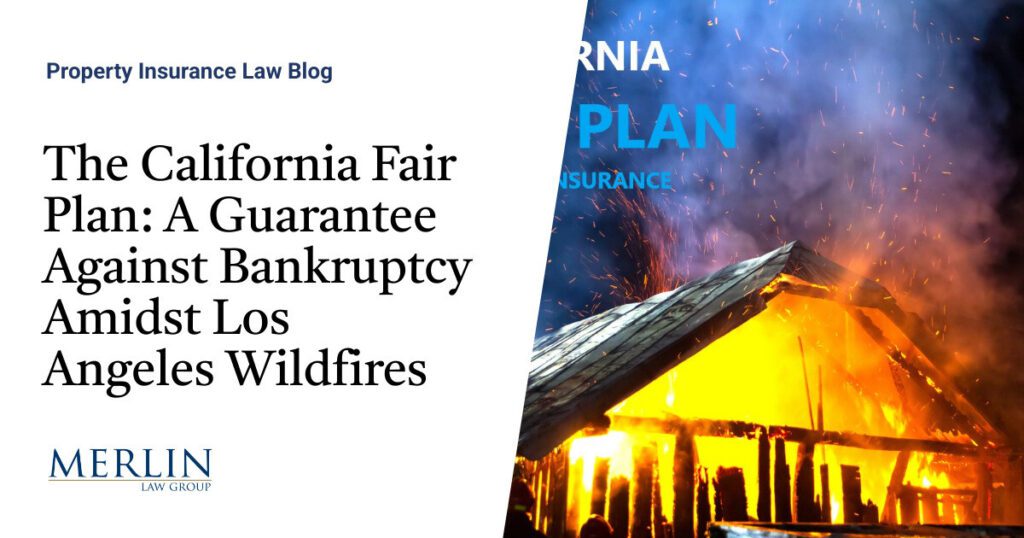The California Fair Plan: A Guarantee Against Bankruptcy Amidst Los Angeles Wildfires

I was recently asked on a FoxNews interview whether policyholders with California’s Fair Plan will be paid if it runs out of money. The wildfires in Los Angeles have caused widespread devastation, leading to concerns among policyholders and others about whether the California FAIR Plan can fulfill its obligations. Misleading reports have fueled fears that the FAIR Plan could go bankrupt and leave homeowners without recourse. It is critical to clarify how the California FAIR Plan operates, its history, and its financial safeguards to reassure policyholders and correct misconceptions. Dan Veroff wrote an extensive article about the California Fair Plan in “What Is the California FAIR Plan?”
The History and Purpose of the California FAIR Plan
The California FAIR (Fair Access to Insurance Requirements) Plan was established in 1968 following riots and natural disasters that made traditional insurance carriers hesitant to underwrite policies in high-risk areas. It was created as a safety net to provide property insurance for individuals and businesses unable to obtain coverage in the voluntary market due to heightened risks such as wildfires, earthquakes, or civil disturbances.
Unlike traditional insurance companies, the FAIR Plan is not a private entity seeking profit. Instead, it operates as a shared market mechanism, with all admitted insurers in California participating as members. Every licensed insurer in the state is required by law to contribute to the FAIR Plan, ensuring that it remains a stable and reliable source of coverage.
Current Status of the FAIR Plan
The FAIR Plan currently insures a significant number of properties across California, particularly in wildfire-prone regions. While the financial demands of major disasters like the ongoing Los Angeles wildfires may strain its treasury, this does not mean the plan is at risk of insolvency. The FAIR Plan’s financial health is underpinned by statutory mechanisms designed to prevent bankruptcy and guarantee that claims are paid.
The FAIR Plan’s Financial Safeguards
Premium Collection: Like any insurer, the FAIR Plan collects premiums from policyholders to fund its operations and pay claims. These premiums are calculated to reflect the risks covered and are adjusted periodically to maintain financial solvency.
Reinsurance: The FAIR Plan purchases reinsurance, a financial tool that transfers a portion of its risk to other insurers. In the event of a catastrophic loss, reinsurance helps ensure that the plan can meet its claim obligations without exhausting its own reserves.
Assessment Authority: One of the FAIR Plan’s most significant safeguards is its statutory authority to assess all member insurers if its funds prove insufficient. This means that every admitted insurance carrier in California is obligated to contribute additional funds to cover shortfalls. This mechanism effectively ensures that the FAIR Plan has access to a virtually unlimited pool of resources, making bankruptcy nearly impossible.
State Oversight: The FAIR Plan is regulated by the California Department of Insurance, which monitors its financial practices, reserves, and solvency. The Department ensures that the FAIR Plan operates responsibly and can fulfill its commitments to policyholders.
While it is natural for homeowners to worry about their coverage in the wake of disasters, it is important to emphasize that the FAIR Plan is designed to withstand precisely these types of challenges. Unlike private insurers, which might exit markets or limit coverage in response to financial pressures, the FAIR Plan is a public-oriented institution with built-in safeguards to ensure continuity of coverage.
Policyholders can take comfort in knowing that even if the FAIR Plan’s current treasury is stretched by wildfire claims, its ability to access additional funds through assessments and reinsurance guarantees that claims will be paid. The California insurance market as a whole shares the responsibility of supporting the FAIR Plan, reinforcing its financial stability.
Thought For The Day
“The only thing we have to fear is fear itself.”
—Franklin D. Roosevelt



